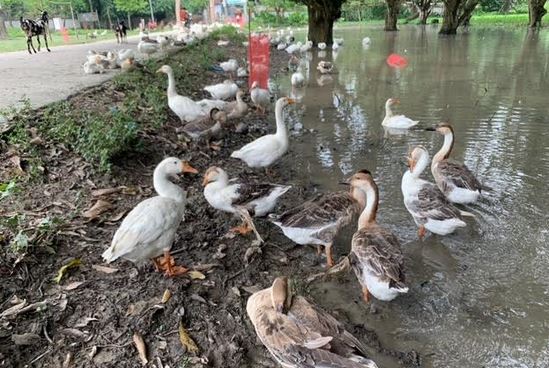News Flash

MEHERPUR, Sept 22, 2025 (BSS) - Swan rearing is rapidly growing in popularity and profitability across the district, driven primarily by the high local demand for swan meat.
The trend is helping boost the local economy, particularly by aiding distressed families in coping with financial hardship.
Groups of swans are now commonly seen roaming majestically on village roads and next to ponds and ditches. Many urban and suburban residents are establishing mini-farms at home, generating supplementary income through this practice.
Talking to BSS, district Livestock Officer Subrata Kumar Banerjee noted that swan rearing is increasing in Meherpur because it is highly profitable.
“Rearing costs are reduced when firms are located in grassy lowland areas, as swans naturally fulfil more than half of their dietary needs by consuming grass. Swans are unique in that they are the only species that feeds on grass and creepers, similar to cows and goats. Swans also procure food, such as grass, from water bodies,” he added.
Major rearing areas in the district include Govipur, Harirampur, Tegharia, Radhakantpur, Kulbaria, Chandpur, Baikunthpur, Subalpur, Nishchintpur, Amjhupi, Garabaria, Dariapur, Gangni, Bamundi, Ramkrishnapur Dhala, Bil Dhala, Bhomordah, and Kaligangni.
Flocks of swans are frequently seen moving along and within the Bhairab River in Meherpur. The number of swans in the region is increasing annually.
Hanufa Begum of Govipur village maintains 30–40 swans regularly. She utilizes the earnings from selling the swans to purchase feed for the flock, while also meeting her family’s meat requirements.
Zebun Nessa of Bhomordah village, in Gangni Upazila, started her farm after her husband’s death. She bought two swans which laid 10 eggs, and she successfully hatched the chicks. She now possesses 85 swans, each weighing between 4 to 6 kg.
Swans generally suffer from few diseases. The primary health risk is duck plague, though the disease is kept in check by occasionally administering preventative vaccines.